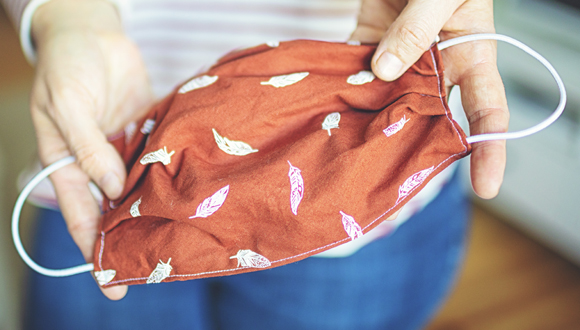By Katie McCallum | Houston Methodist
April 7, 2020 – To wear a mask or not to wear a mask? This question has been up for debate since the beginning of the coronavirus (COVID-19) pandemic.
In the early days of the pandemic, public health experts asked healthy people to avoid wearing face masks — as these are critical medical supplies that must be reserved for healthcare workers. There’s also the notion that wearing a mask could instill a false sense of security in some people, making you more likely to venture outside of your home more than necessary and disregard social distancing recommendations.
As the COVID-19 situation has become more widespread and more serious, guidance from public health officials around covering our faces has shifted. In fact, the Centers for Disease Control and Prevention (CDC) is now recommending that you wear a cloth face covering while out in public, especially if you live in an area with significant community spread.
If you’re confused about mask guidelines and are looking for answers, here are four things you need to know about the new face covering recommendations.
Face covering recommendations shifted because of what we’ve learned
Early during the pandemic, we learned how important it is to practice the preventive measures that keep you from being infected with COVID-19, like washing your hands, practicing social distancing and frequently disinfecting commonly touched surfaces.
As the virus became more widespread, we learned about the safety measures you should take if you’re showing signs and symptoms of COVID-19, such as practicing proper cough etiquette and self-quarantining.
But what about if you’re infected and you don’t even know it?
It’s becoming increasingly clear that a person can spread COVID-19 even when he or she is asymptomatic, which is important for two reasons. First, it can take between two and 14 days after being infected with the new coronavirus to begin showing symptoms. During this presymptomatic time, people you come into close contact with are at risk for becoming infected. Second, some people infected with coronavirus never actually develop symptoms. In fact, Dr. Robert Redfield, director of the CDC, stated that a significant number of people infected with the virus remain asymptomatic — maybe as many as 25%.
What public health experts have learned is that asymptomatic infected individuals are more prevalent than originally anticipated. In addition, these individuals do in fact contribute to the spread of the virus.
In short, even if you’re feeling fine, you could still be infected and unknowingly spreading COVID-19.
Given this new information, the CDC is now recommending that the general public wear cloth face coverings in an effort to slow the spread of coronavirus — especially if you live in an area with community spread. This recommendation isn’t really about protecting yourself from getting COVID-19, but more about preventing you from unknowingly spreading the illness to healthy individuals.
A cloth facing covering is not the same as a surgical mask
Now that we know why the face covering recommendations shifted, it’s time to talk about what’s considered an appropriate face covering.
A cloth face covering is a cloth-based face covering that you make at home using common materials, such as a bandana or old t-shirt.
Cloth face coverings are not the same as surgical masks or N-95 respirators — which are critical supplies that must be reserved for healthcare workers. If you have unopened packages of surgical masks or N-95 respirators, consider donating these important personal protective equipment (PPE) items to your local hospital.
There’s a right way to covering your face correctly (and safely)
So you need to make your own cloth-based face covering and don’t know where to start? You’re not alone. Fortunately, the CDC provides instructions for making several types of homemade cloth face coverings, including directions for making one using just scissors and an old t-shirt. There are also instructions for sewn cloth face coverings, as well as bandana face coverings (which require rubber bands and a coffee filter).
No matter which type of homemade cloth-based face covering you choose, keep these do’s and don’ts in mind:
- Do make sure it fits snug to your face while covering your nose and mouth
- Do make sure it stays securely in place (consider using rubber bands, if needed)
- Do make sure to include several layers of fabric
- Do wash it regularly in the washing machine
- Don’t let it restrict your breathing
- Don’t touch your eyes, nose or mouth while removing it and before washing your hands
- Don’t use a mask that has lost its form or function after being washed
In addition, cloth face coverings are not recommended for certain people, including:
- Children under the age of 2
- Individuals who have difficulty breathing
- Individuals who are unable to remove the mask without assistance
You still need to practice social distancing
While cloth face coverings are recommended to help prevent and slow the spread of COVID-19, this new effort does not replace the need for social distancing or any current stay-at-home orders.
Social distancing is still the most important community-based effort we can use to “lower the curve” — helping to keep high-risk people safe and reduce the burden placed on our health care system. Public health epidemiological modeling continues to show that COVID-19 cases could skyrocket if social distancing efforts are relaxed or not maintained for the coming weeks.
This means that just because you have a cloth face covering ready for use, you should still continue to stay home as much as possible and keep six feet of distance between yourself and others when you do go out.
Concerned you may have COVID-19?
If you’re experiencing COVID-19 symptoms, you can speak to a Virtual Urgent Care provider 24/7. The provider will help you determine if testing is needed and advise you on where you should go.
For more information, visit https://www.houstonmethodist.org/blog/articles/2020/apr/coronavirus-what-you-need-to-know-about-the-new-cloth-face-covering-recommendations/


